Understanding
image sharpness:
Digital
cameras vs. film, part 2
by
Norman
Koren
updated Sept. 18, 2005
In Digital cameras vs. film,
parts
1 and 2, we use the tools developed in earlier in the
series
to compare digital and film cameras, and we address the question, "How
many pixels does a digital sensor need to outperform 35mm film?"
The answer is less speculative than it used to be: The 11+ megapixel
Canon
EOS-1Ds, EOS-1Ds Mark II, and EOS 5D
clearly outperform 35mm. I can make finer prints with the 8.3 megapixel
EOS 20D (razor sharp at 13x19 inches) than I ever could with 35mm— and
I was fanatic about lenses and darkroom work. We also look at the rapid
advances of
digital sensor technology, which have made some digital cameras
obsolete
in a matter of months. The good news is that the advances are slowing
down--
digital cameras are stabilizing and it has become safe to buy one
without
fear of rapid obsolescence (though
obsolescence
will still happen; just slower).
Part 1 describes the four pillars
of
image quality, digital image sensors, the simulation technique, and
presents
a summary of results comparing digital camera resolution with film. Part
2 contains Dennis Wilkins' comparison of the Nikon D100 with
film,
my view of the future of digital cameras, Links, a discussion of
Information
theory and image quality, and how to measure MTF from Dpreview.com test
results. I can't keep up with all the latest camera models. Sites with
the latest news and reviews are listed in Digital
cameras: Links. Digital camera sharpness measurements are
available on Imatest sharpness
comparisons.If you are unfamiliar with MTF, you may want to review Part
1 of the Understanding image sharpness series.
| Green
is for
geeks. Do you get excited by an elegant equation? Were
you
passionate about your college math classes? Then you're probably a math
geek-- a member of a maligned and misunderstood but highly elite
fellowship.
The text in green is for you. If you're normal or mathematically
challenged,
you may skip these sections. You'll never know what you missed |
Dennis
Wilkins' comparison of the Nikon D100 with Reala film
My friend Dennis Wilkins, who recently took early retirement
as a
quality
control guru at Hewlett-Packard, took time off from his busy consulting
schedule to perform the following comparison between his new Nikon D100
digital (23.7x15.6 mm sensor; 1.52x
focal length multiplier) and his traditional Nikon N70. The test chart,
made years ago by Paterson
Photographic Ltd., is apparently long out of production. Here are
his
comments, slightly edited.
Same
lens (Nikkor
24-120mm @ 50 mm), same f-stop (f/11), same tripod, same brand of
camera
(Nikon), N70 with Fuji Reala at ISO 100 vs. D100 at ISO 200 (sorry, it
goes no lower). D100 shot at 1:39 ratio, N70 shot at 1:26 ratio in
order
to make the overall image scale the same due to 1.5:1 lens multiplier.
Thus, everything is the same except the focusing distance, which should
have little effect on resolution. (The lens is not the limiting factor
here.)
1.
Reala, ISO 100,
scanned on a Canon FS4000 at 4,000 dpi, no extra sharpening. (The Canon
has built-in sharpening that can't be turned off).
2. D100,
ISO 200,
normal sharpening. The scale actually represents approximately 7.5 to
75
lines per mm (that 1.5x multiplier).
3.
Reala, ISO 100,
same scan as 1, with extra sharpening .
Film images 1
and 3
have more grain than 2, with more grain visible in 3 due to
sharpening.
The mottling of the cyan ink in digital image 2 resembles the
target
itself (the black, yellow and magenta have smoother ink coatings). The
D100 image appears sharper than even the extra sharpened Reala/Canon
scan.
These are at 1:1 for the D100 scale (I had to adjust scales because the
D100 imager is only 70% the dimensions of 35mm) and represent a section
of an enlargement that would be 28" x 42". I tried (not totally
successfully)
to make the tones the same.
The D100
resolution chart
shows some moiré interactions down in the 30-35 lp/mm range
(which
is really not that value at the actual D100 scale -- it's really more
like
45-50 lp/mm). Note this Moiré effect is rarely of concern
because most
real photos don't contain such precise, repetitive, high-contrast pitch
elements. (It could be a problem with fabrics in fashion
photography--
NK).
Dennis's comparison of the D100 vs. the
10D can be found on my 10D page.
My (NLK) observations: The D100 has higher contrast up to
nearly 30
on the scale (roughly 45 lp/mm) and much less noise (grain). Response
above
30 is mostly artifacts. Reala scanned at 4000 dpi has resolvable detail
to over 35, but contrast is very low above about 28 and the image is
noticeably
grainy. Overall image quality looks better with the D100.
These tests agree reasonably well with my simulation
results.
|
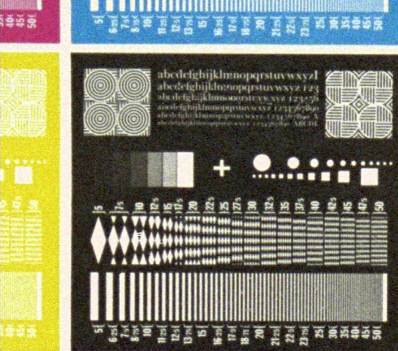
1. Reala, ISO 100, 1:26, 4000 dpi scan.
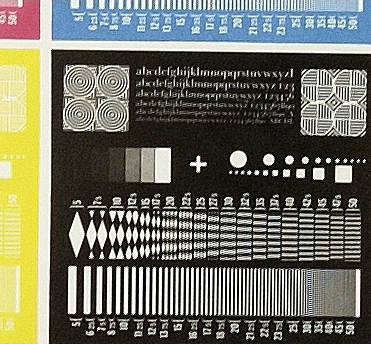
2. D100, ISO 200, 1:39, normal sharpening.
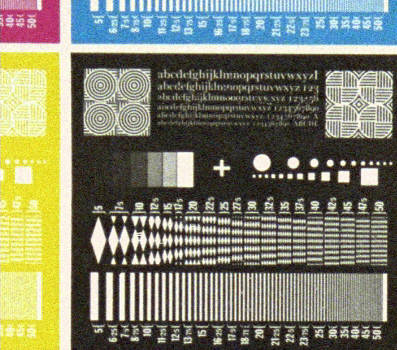
3. Reala, ISO 100, 1:26, 4000 dpi scan, extra sharpening.
|
The
future of digital cameras
There are several broad categories of digital cameras:
- Compact digital cameras with sensors up to 11 mm diagonal
come in
several varieties, usually with one or more dominant features, such as
- Basic low-cost point-and-shoot
- Ultra-compact
- Large aperture lens
- Large zoom ratio (up to 12:1) with long telephoto
- High pixel count (6+ megapixels)
11 mm diagonal sensors are very small-- 1/4
the length and 1/16 the area of a 35mm frame, and many of these cameras have smaller sensors. But most are sharp enough
to make outstanding 8˝x11
inch
prints, and many can make decent 13x19 inch prints. Prosumer sensors seem to be stabilizing
at around 6-8 megapixels. The Pixel spacing for typical 8 megapixel sensors is tiny--
2.7 µm vs. 3.4 µm for 5 megapixel sensors. Noise can be
relatively high (especially at ISO speeds greater than 100) and
exposure range is limited. But resolution seems to be
excellent--
better than the 5 megapixel models. I believe 8 megapixels is about as
far as compact digital cameras are likely to go; they require fine
(i.e., expensive) lenses to reach their potential. More (smaller)
pixels
would
be noisier and offer little advantage in resolution, which would be
limited
by lens quality and diffraction. There will be progress in other
aspects of sensor
performance.
For example, Fuji's new Super
CCD SR promises increased exposure (dynamic) range. Progress in compact digital cameras won't be as dramatic
as it was before 2004; it will consist of more refined feature
sets, better battery life, less shutter lag, wireless communications,
and lower cost-- a relief to those who worry about their investments
becomming
obsolete overnight.
- Digital SLRs with sensors smaller than full-frame 35mm (22-28 mm diagonal). These include cameras with APS-C-sized sensors (around 27mm diagonal), such as the
Nikon D50, D70, and D100, and the Canon EOS-20D and Digital Rebel, and the Olympus-Kodak
Four-thirds inch initiative (22 mm diagonal sensors), with the Olympus
E-1
as the flagship. These cameras are a compromise between compacts, which
can
be noisy and have a limited exposure range, and full-frame 35mm
sensors, which are far more expensive: Sensor cost increases rapidly
with size, scaling with at least the third power of sensor area.
At first I thought these cameras were a stopgap measure on the way to
full-frame cameras. I was wrong. They're here to stay. Compared to the
full-frame cameras, they are much less expensive and slightly
smaller and lighter. Several manufacturers (Canon, Nikon, Sigma,
Tamron, Tokina) now make lenses for this format. These lenses are
sharper, smaller, and lighter then their counterparts that cover the
full 35mm frame. The image quality in the best of these cameras equals
35mm: I can make better 13x19 inch enlargements with my Canon EOS-20D
than I've ever seen from 35mm.
There cameras will continue to evolve: pixel count will increase,
topping out at around 12 megapixels, and feature sets will improve.
Wireless technology will become commonplace. But don't expect anything
really dramatic. I have some doubts about the Four-thirds standard. The
Olympus cameras are technically excellent, but there is no upward
migration path for photographers who want to upgrade to full frame
cameras.
- Digital SLRs with full-frame 35mm (44 mm diagonal) sensors
are
the
cameras
of choice for professionals and serious amateurs who can afford them.
The best of them-- the Canon EOS-1Ds Mark II-- has image quality
comparable to medium format film (645). The recently-announced EOS 5D
comes close, and it is smaller, lighter, and less expensive. The number
of pixels in full frame cameras will slowly increase, topping out
around 24 megapixels. There would be little benefit from more pixels:
resolution would be limited
by
the lens, and noise, dynamic range, and yield would deteriorate. Prices
will
continue
to drop as sales and sensor manufacturing yields increase. I am
considering the purchase of and EOS 5D in 2006.
- Cameras/backs with sensors larger than 44 mm diagonal.
Very
expensive;
primarily of interest to professionals. An example is the 22 megapixel Sinarback
54, which uses the Kodak KAF-22000CE
CCD image sensor: 4080 x 5440
pixels,
9 µm pixel spacing, about 36x48
mm image size-- twice that of 35mm and close to full frame 645 medium
format.
It is capable of making sharp 24x32
inch prints. If you have to ask the price... See Michael Reichmann's Survey
of Current Medium Format Digital Backs. I'll pay more attention if
and when they become affordable (or I strike it rich).
Here are my digital camera fantasies.
Fantasy 1 is already here in 2005, but it's very expensive.
.
| Sensor |
Sensor
size
mm
(diag.) |
Pixel
array
(total
Mpxls) |
Pixel
spacing
(µm) |
MTF
lp/mm
50%/10% |
Resolution
relative
to
35mm |
Comments |
| Fuji Provia 100F, excellent
lens,
4000 dpi scan, sharpened |
36x24
(43.3) |
3779x5669
(21.4) |
6.35 |
46.7 / 71.8 |
(1.0) |
The benchmark for high quality 35mm
color slide film. Similar
resolution to 10.2 µm pixels. s
= 0.2. |
Fantasy 1: Same pixel spacing as the EOS 10D,
filling a 24x36mm
frame.
Realized by the Canon EOS-1Ds Mk II (Oct. 2004)
|
36x24
(43.3) |
4864x3242
(15.8) |
7.4 |
61 / 84 |
1.30 |
Finer pixels than the EOS-1Ds.
Performance comparable
to medium format. |
| Fantasy 2: 6 µm pixels, filling a 24x36mm
frame. |
36x24
(43.3) |
6000x4000
(24) |
6.0 |
72.3 / 101 |
1.55 |
Could be optimum
for full-frame
Bayer mask sensors. s
= 0.27. |
| Fantasy 3: X3 sensor, same spacing as the
SD9/SD10, filling
a 24x36mm frame. |
36x24
(43.3) |
3948x2630
(10.4) |
9.12 |
64.7 / 83.7 |
1.38 |
Sinc1.5
assumed. Performance
comparable medium format. s
= 0.24. |
| Fantasy 4: X3 sensor, same spacing as the D60,
filling a 24x36mm
frame. |
36x24
(43.3) |
4864x3242
(15.8) |
7.4 |
73.7 / 99.2 |
1.58 |
Performance may
surpass medium
format if such a sensor could be built. s
= 0.22. |
| MTF
and resolution were calculated by MTFCurve2, using the same assumptions
as the previous table. |
|
The handwriting is on the wall for film. 16
megapixel sensors
(10 for the X3 sensor, if they can produce it) have resolution challenging
medium format film. Large users of film have already switched to digital.
Film
sales are rapidly dropping. Film production lines will shut down as sales drop.
Variety will decrease and prices will increase. Traditionalists will
complain,
but the quality of digital images will carry the day. At 16 megapixels,
many traditional view camera applications are migrating to digital,
where
they can take advantage of Canon and Nikon tilt-shift lenses that turn
35mm/digital cameras into baby view cameras.
Moore's
law for semiconductors (named for Gordon Moore, co-founder of
Intel)
states that the complexity of silicon chips doubles approximately every
18 months. For years digital sensors progressed more slowly, but the
growing
market sped up progress between 1998 and 2003-- the 3.11 megapixel
Canon
EOS D30 was followed by the 6.3 megapixel D60 in about 18 months and
the
11 megapixel EOS-1Ds a year later. However Moore's law applies
primarily
to digital logic chips, which keep shrinking, whereas digital sensor pixels
can't shrink indefinitely. Quality is diminished--
film speed and exposure range and noise get worse-- as pixel size
decreases.
Pixel spacings below 5 µm probably won't
meet
professional standards; the gain in resolution won't be sufficient to
compensate
the increased noise and decreased exposure range. For high
quality
imaging, pixels will remain in the optimum
6-9 µm range, and sensor sizes will be APS-C or larger.
Supporting technologies-- flash memories and microdrives-- will
continue
to advance with the speed of Moore's law. Image processing workflows
for
both amateurs and professionals will improve-- driven by huge potential
profits. New wireless technologies will allow images to be uploaded from
cameras
in near-realtime:
Bluetooth,
for devices within 10 meters, and Qualcomm's
third-generation data-optimized wireless technology (1xEV-DO).
Either of these will boost a camera's storage capacity to
near-infinite--no
more changing film or PC cards. Uploads can be done in the background
without
intervention by the photographer-- the possibilities are quite
staggering.
Thom Hogan has some interesting
prognostications in What
Will Happen in 2004? (His What
Will Happen in 2003? is also very interesting. This link may be behind...)
Links
George Nyman has created a very clear comparison between digital and film: Brief
Comparison of CANON 20D, NIKON D70S, CANON 1D MkII, PENTAX *istDS,
K-MINOLTA D7, Fuji S3Pro and NIKON D2X with FILM (35mm, 4,5x6,6x6, 6x8).
Peter Wolff's
clear
comparison of the EOS-1Ds
with 35mm and medium
format in Photographical.net
(excellent site) is most interesting. Summary (no surprise): The
EOS-1Ds
trounces 35mm and seriously challenges medium format.
Scientific
test report comparing current digital cameras with 35mm SLR film cameras
by Anders Uschold. Contains
experimental
data on the Canon D60, Nikon D100 and Fuji S2 Pro. Examines the
interaction
of lenses and digital sensors with data from several excellent lenses.
Translated from German; awkward in places. Related articles covering
testing
techniques are available in German;
they will be added to the English
language pages in the next few months. Anders organized a symposium
on Digital
image capture – Camera testing and quality assurance at Photokina
2002.
The PDF
presentations, covering resolution, dynamic range and image quality
issues, are extremely interesting. I would love to see full text
versions.
Optics
for digital photography A white paper from Schneider
Optics. Rather poorly written-- some of the numbers assume you
would
never enlarge more than 7.5x11
inches
(A4), but interesting nonetheless. Outlines lens design goals for
digital
cameras: Maintain high MTF to some fraction of the Nyquist frequency
(RMAX
= 1/(2*pixel spacing)), then have MTF drop as rapidly as possible so
the
MTF of the lens+sensor (calculated in the tables above) at Nyquist is
no
more than about 10%. This keeps aliasing under control. Figure 2 has a
glaring error: edges in the brightness distribution would be softened
by
the MTF response. The middle and right would resemble sine waves.
Sony
CCD data sheets Some of their sensors are as small as 5 mm
diagonal
(35mm is 43.3 mm diagonal). The Sony DSC-F707 uses one of the 11 mm
diagonal
5.07 Megapixel ICX282
series sensors. Pixel length is a tiny 3.4 µm. No
anti-aliasing
filter is needed. These tiny pixels have more noise and less dynamic
range
than larger (over 6 µm) pixels.
Kodak image
sensor
solutions Links to technical information and valuable
articles.
Their high-end sensors are the KAF
Blue Plus Color Series. The sensor for the Kodak DCS 14n is made by
The
Fill Factory.
Fairchild
Imaging's CCD595 CCD sensor has 85
Megapixels !!! 9216x9216 8.75 µm pixels;
8.064 cm2. It's designed for aerial reconnaissance. My
budget is a bit smaller than the Pentagon's (as is my deficit), but I
can
always dream.
Film versus Digital
Cameras by Robert Monaghan. Heated debate punctuated by some
valuable
technical information.
Roger N. Clark,
Ph.D.
in Planetary Science from MIT and avid photographer, has some valuable
information on digital resolution. His recent page on Film vs. digital has some interesting comments on dynamic range, which is superb with digital.
Ken Rockwell's views
on
digital vs. film
are based on his experience in the film industry. I disagree with many
of his statements, but when when you compare 4x5 film to a 6 megapixel
DSLR, what's to disagree, duh?
Tawbaware.com
has done a nice little film vs. digital test-- a good reality check on
my calculations.
ST Microelectronics (UK) has some interesting technical pages on CMOS
sensors.
Horst Kretzschmar ( www.eos-d60.de
) is planning a series of lens tests on the Canon EOS D60 using my lens
test charts.
Anatomy
of a Digital Camera: Image Sensors from Extremetech.com.
Canon Digital
Photography
Forum (not an official Canon site) Excellent discussion
forum.
Digital
Images:
Foveon X3 versus Bayer by Mike Chaney of Qimage
Pro A nice simulation illustrating the superiority of the
Foveon
sensor.
RIT Center
for Imaging Science class material is a serous resource-- well
worth
exploring. Basic
Principles
of Imaging Science 1. Lectures 17
and 18
on MTF and imaging microstructure are particularly interesting.
Mikhail "Teddybear" Sokolov
has
some interesting material comparing the Fuji S2 Pro digital SLR with
film
and other digital cameras. Mostly Russian, but this
link is good for translations. See two dpreview.com posts: The
most over asked question (image comparisons) | Fuji
SLR Talk (chart comparisons)
.
| Information
theory and image quality |
| The electronic communications
industry has its
roots in Claude Shannon's pioneering work on information theory. His
classic
equation for the information transmission capacity C of
a
data channel is,
C = W
log2(SNR+1)
W is the bandwidth
of the channel, which corresponds to the 50% MTF frequency f50--
the perceived image sharpness. ( f50 is the -3
dB frequency because light intensity is measured as power.)
SNR is the signal-to-noise
ratio (a dimensionless fraction). Grain is noise in film.
Unlike
bandwidth, SNR is difficult to quantify. RMS
(root
mean square) noise is the standard deviation (sigma) of the
pixel
level in a smooth image area. It is easy to measure, but it doesn't
tell
the whole story. For that, you must measure the noise sectral
density,
then weight the noise to to emphasize frequencies where the
human eye is most sensitive. These frequencies are dependent on the
degree of enlargement and viewing distance. High frequency noise is
invisible
in small enlargements, but may be highly visible in big enlargements.
Noise
metrics such as Kodak's print
grain index, which is perceptual and relative, takes this into
account.
The signal depends on the subject
matter. It is
highest, hence SNR is highest, in textured, detailed areas. It is
lowest,
hence noise and grain are most visible, in smooth areas like skies.
Shannon
information capacity C is different for different images. To
compare
cameras you would have to choose some artibrary signal level, like a
fraction
(perhaps 50 or 100%) of the difference between white and black on a
reflective
target.
If MTF alone
determined image quality
it would take 12 megapixels (36 megapixels after interpolation) for a
digital
camera to outperform 35mm. But noise/grain plays an important role. So
I would like to present a modest hypothesis.
Perceived
image quality is proportional to total information capacity, which is a
function of both MTF (sharpness) and noise (grain).
I can't provide experimental proof, but it seems to fit a great many
observations.
It's one of the reasons many photographers prefer slide films, which
may
be slightly less sharp than
negative
films but have much less grain.
Remember, this is a hypothesis,
i.e., a conjecture-- a starting point for further study. More needs to
be done to establish a reference signal (the S in SNR),
appropriate
spectral noise weighting (a function of magnification and viewing
distance),
and the effects of dynamic range, which is scales with pixel
size). And of course tests need to be done with impartial
observers.
A nice academic project...
The
image quality of digital cameras will equal 35mm with fewer pixels than
predicted by MTF alone because digital cameras have much less noise.
The hypothesis fails for extremely high values of SNR. Improving SNR
(decreasing
image noise) only helps up to a point. I would like to propose a
remedy,
based on the observation that the eye can distinguish about 100 levels
in a reflective image, which has at most a 100:1 density range. The eye
itself is a source of noise-- if it were noiseless, it could
distinguish
an infinite number of levels. The eye noise level is 1/100 = 0.01,
based
on the reflective target. If image noise is defined as the standard
deviation
of the gray level divided by the difference between white and black
levels
( image noise = std(gray)/(value(white)-value(black)) ), we can define
a total noise = sqrt(image noise2 + eye noise2).
This would limit the effective SNR for high values of image SNR.
Skies in digital camera images with pixels
larger than about 6 µm are virtually grainless. That makes a big
difference in perceived image quality. Many photographers will perceive
images from the current generation of high-end 6 megapixel cameras--
the
Canon EOS 10D and the Nikon D100-- to be equal to 35mm. We
are there now!
Digital camera images I've seen (from modest as
well as fine cameras)
are sharp right down to the pixel level. This can be difficult to
achieve
with a high resolution film scan because it requires sharpening, and
sharpening
increases grain. To minimize grain enhancement, I usually use unsharp
mask
with a threshold and mask out the sky. But you can only sharpen
a film image so much before it gets ugly.
Miles Hecker
has taken my speculation on digital image quality and run with it. His
excellent article is on Luminous-landscape.com.
|
|
|
.
| Measuring
MTF from ISO 12233 charts |
Both dpreview.com
and imaging-resource.com
publish test images of the ISO 12233 test chart. With the procedure
below you
can use them to estimate the 50% MTF
frequency. But it's rather tedious.
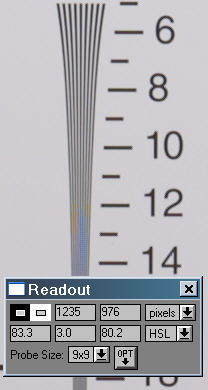 Several
portions of the ISO
12233 resolution test chart are typically printed on the last
"Image
Quality" or "Compared to..." page in each dpreview.com test report. A
portion
of the EOS D30 chart is shown on the right. You can download
and
save complete resolution charts (as large, high quality JPEGs) by
right-clicking
on any of the reduced or cropped images. On
imaging-recource.com,
the chart can be found on the Sample images pages. Several
portions of the ISO
12233 resolution test chart are typically printed on the last
"Image
Quality" or "Compared to..." page in each dpreview.com test report. A
portion
of the EOS D30 chart is shown on the right. You can download
and
save complete resolution charts (as large, high quality JPEGs) by
right-clicking
on any of the reduced or cropped images. On
imaging-recource.com,
the chart can be found on the Sample images pages.
To
analyze a chart,
load it into a program such as Pixel Profile or ImageJ, described
below, that allows you to
measure
the following values. Image
editors can also be used, but they're less convenient.
| VB |
The average luminance for
black areas. |
| VW |
The average luminance for
white areas. |
| Vmin |
The minimum luminance for a
bar pattern at a
given frequency or scale value (the "valley" or "negative peak"). |
| Vmax |
The maximum luminance for a
bar pattern at a
given frequency or scale value (the "peak"). |
Use the following equations to
find MTF.
| C(0) = (VW-VB)/(VW+VB)
is the low frequency (black-white) contrast. Contrast defined in this
way,
normalized to (divided by) (VB+VW),
minimizes
errors due to nonlinearities in acquiring the pattern. |
| C(f) = (Vmax-Vmin)/(Vmax+Vmin)
is the contrast at spatial frequency f. |
| MTF(f) ~=
78.5%*C(f)/C(0),
where C(f) < 0.7*C(0) The 78.5% factor is explained in the box
below. |
.
 Approximating
MTF Approximating
MTF
MTF is based on sine wave
response, but we often
work with bar charts. The contrast ratio obtained directly from a bar
chart
is called the contrast transfer function, CTF(f) = 100% * C(f) / C(0).
CTF is rarely referred to in the literature. It is not
the
same as MTF.
A portion of a bar chart can
be approximated by
a periodic function called a square wave, illustrated above for period
2L (frequency = f = 1/2L). Fourier transform mathematics
teaches us that any periodic function can be expressed as an infinite
sum
of sine functions, starting with the fundamental, sin(pi*x/L)
= sin(2*pi*f), and
including
harmonics, sin(n*pi*x/L)
= sin(2*n*pi*f)
for n = 2, 3, 4, ... The equation for the square wave is shown
above.
It only has odd harmonics (n = 3, 5, 7,...). The amplitude of
the
fundamental frequency of the bar pattern is 4/pi = 1.273 times the
amplitude
of the bar pattern itself. To obtain MTF from CTF you must
multiply
by a factor of pi/4, hence,
MTF(f)
= 0.785*CTF
~= 78.5%*C(f)/C(0),
where C(f) < 0.7*C(0)
This equation is only accurate
at relatively high
frequencies where response is dropping-- where the harmonics are
strongly
attenuated. These are the frequencies of interest.
The exact
equation for relating
MTF(f) to CTF(f) was given by Coltman (1954):
MTF(f) = pi/4 *
[CTF(f) + CTF(3f)/3 -
CTF(5f)/5 + CTF(7f)/7 ...]
The signs in
this equation beyond n
= 7 are quite irregular. This equation is rarely of practical
interest--
pure geek stuff. I owe thanks to Chuck
Varney for straightening me out on these issues.
|
There two basic ways to analyze
the chart.
- Load the saved chart into an
image editor that has
a readout tool. A portion of the chart for the Canon EOS D30 is shown
above,
along with the Picture Window Pro
readout
tool. Zooming in larger that 1x
(one
screen pixel per image pixel) allows a clearer look at the chart.
In PW Pro, bring up the readout tool by clicking Tools,
Readout, and select HSL.
The
default probe size is 3x3 pixels:
change it to 1x1 for MTF measurements.
Observe the average
luminance (L in HSL)
for black and white areas, VB and VW. A large
probe
size (up to 9x9) makes this easier.
For the D30 chart (on the right), VB = 18% and VW
= 80%. (100% = pixel level 255.) C(0) = (VW-VB)/(VW+VB)
= 0.633.
Now zoom in on the portion of the
chart shown,
located near the right-center. Set the probe size to 1x1
pixels. Run the probe across the pattern at some point on the scale,
looking
for the average minimum and maximum values, Vmin and Vmax.
It may take a while to get the hang of it. For the D30 chart at scale =
10 (about 33 lp/mm), Vmax ~= 65% and Vmin ~= 43%.
C(f) = (Vmax-Vmin)/(Vmax+Vmin)
= 0.204. MTF(scale=10) ~= 78.5%*C(f)/C(0) = 25%.
This
technique is only as good as your estimate of Vmax and Vmin:
maybe about ±10%. The technique below is slightly more accurate.
- Use a program that plots
image
pixel luminance. PixelProfile
is easy to use; its operation is largely self-explanatory,
but it is limited to 640x480 pixel
image size; you'll want to crop the image and save it as a maximum
quality
JPEG before loading it. ImageJ
is
more versatile-- it can handle larger images.
A PixelProfile
intensity plot (same as HSL Lightness) is shown below for the D30
chart at scale = 10 (about 33 lp/mm). VW = 207, VB
= 45, Vmax = 167, and Vmin = 115 (Vmax
and Vmin are both averages). Plugging into the above
equations,
C(0) = 0.643, C(scale=10) = 0.184, MTF = 78.5%*0.184/0.643
= 22%. This approach is slightly more accurate than the first approach.
The scale on the chart is the number
of line widths
per picture height divided by 100, 00 has been dropped to save space.
For
example, 12 represents 1200 lw/ph. But line pairs are
universally
used in MTF charts, and it takes two lines (line widths)
to make one line pair. To get the total line
pairs
for the chart height, multiply the scale by 50. A value of 12
equates
to 600 line pairs per picture height. The equation for line pairs per
mm
is
lp/mm =
scale*50/(picture
height in mm)
| Dpreview.com's
test pages state, "Values on the chart are 1/100th lines
per picture height. So a value of 8 equates to 800 lines per picture
height."
The resolution
page states, "Resolution from this chart is always measured in
lines
per picture height (to keep the pixels square), the numbers seen on the
chart refer to hundreds of lines, so the label "12" refers to 1,200
lines
per picture height." The use of line width
instead of line pairs
is an
old standard, still used by PIMA
/ IT10 to measure TV resolution. It can be confusing because it
differs
from the spatial frequency in MTF charts by a factor of 2. |
At MTF = 50%, C(f)/C(0) = 0.637;
at MTF = 10%
C(f)/C*0) = 0.127. Little sharpening is evident for the 15.1mm high D30
sensor (above). The Moiré and checkerboarding between 12 and 15
( 40 and 50 lp/mm) are caused by the Bayer pattern interpolation
routines. Sharpening
in the image editor boosts MTF frequencies, but, as always, sharpening
comes at a price. It makes high frequency artifacts--Moiré and
checkerboarding--
more visible.
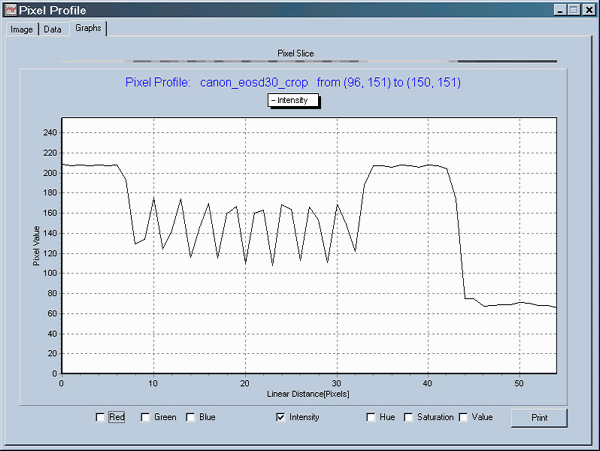
Pixel Profile display
for Intensity (L
in HSL representation) for a section of the above chart at scale = 10,
corresponding to 10*50/15.1 mm = 33.1
lp/mm.
The period of the pattern is (32-8.5)/8 = 2.94 pixels per line pair.
The
0.0102 mm pixel spacing of the D30 corresponds to a period of 0.0300
mm,
or 33.4 lp/mm. Close enough.
|
|

|
Images
and text copyright © 2000-2013 by Norman Koren. Norman Koren lives
in Boulder, Colorado, where he worked in developing magnetic recording
technology for high capacity data storage systems until 2001. Since 2003 most of his time has been devoted to the development of Imatest. He has been involved with photography since 1964. |
 |




